by Nic Haygarth | 11/08/17 | Tasmanian high country history, Tasmanian nature tourism history
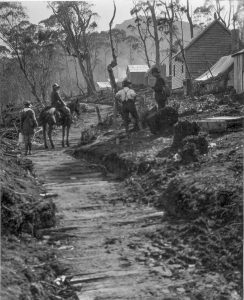
Main Street Adamsfield, 1926, with Ida Smithies and Florence Perrin. Fred Smithies photo courtesy of the Tasmanian Archive and Heritage Office.
In November 1926 a Mrs Gresson advertised tourist accommodation at the Tasmanian mining settlement of Adamsfield: ‘See Tasmania’s Wild West, the “osie” diggers, Adams Falls, Gordon Gorge’.[1] What extraordinary enterprise for a simple digger’s wife 120 km west of Hobart! However, when you learn what an extraordinary woman Lily Gresson actually was, this visionary behaviour comes as no surprise at all.

A water race and the village of Adamsfield, 1926, Fred Smithies photo courtesy of the Tasmanian Archive and Heritage Office.
Her old school Airbnb advert was probably shaped by two events: meeting the one-man promotional band Fred Smithies; and a memorable outing she made to the nearby Gordon River Gorge. Visiting Adamsfield by horseback and pack-horse in February and March 1926, Smithies, an amateur tourism promoter, had snapped the town and its jagged skyline for his travelling lantern-slide lecture ‘A trip through the wilds of the west coast and the osmiridium fields’. ‘Gorges of inspiring grandeur’ and ‘magnificent mountain scenes’ also transfixed Gresson. Decades later she recalled that
‘the scenery to the Gordon River was indescribable. Peak after peak of snow-capped mountains and the Gordon Gorge was so precipitous we would scarcely see the bottom … [it] … was like so many battlements’.
Her party ‘cheerfully stalked along the ten miles of wonderful scenery singing bits of popular songs. This was the first time I had heard [‘]Waltzing Matilda[’], she recalled, ‘and it certainly cheered and helped us along, and home again, when we’—Lily and her husband Arthur Gresson, a veteran of the Siege of Mafeking during the South African War— ‘were beginning to flag’.[2]
Certainly the outing would have come as welcome relief from the routine of life on the Adamsfield diggings. The Gressons had rushed to Adams River in the spring of 1925, after the Staceys from the Tasman Peninsula and their mates struck payable osmiridium. Lily was a woman of great conviction. At a time when few women dared venture among the thousand or so men on the ossie field, she secured her own miner’s right, put together a side of bacon and other requisites, bundled her twelve-year-old son Wrixon onto the train and off they went to Fitzgerald, the western terminus of the Derwent Valley Line, to join Arthur.
Fitzgerald was still 42 km from Adamsfield. Meeting his family there, Arthur hired five horses, including one for Wrixon, who had never ridden a horse before, one for the packer and another to carry the three months’ supply of food and equipment. It was snowing. In parts of the Florentine Valley the mud was up to the horses’ girths, Lily recalled,
‘and they slithered, slipped and plunged into the side track to keep themselves steady. The track was narrow, hastily prepared in very thick scrub, corduroyed also hurriedly—the edges not even adzed. I pitied the poor ‘gees’ [horses] slipping and floundering to try and gain firm footing. I thought I would soon be slipping over their heads and called out to my husband, “Shall I dismount?” “Certainly not”, was the reply, “or you will never get up again.” So I stayed on as best I could following the packer’s lead, for I was behind him. Presently, just around the corner, he shouted, “Look out, the down packs are coming!”’[3]
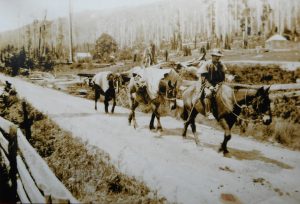
A packer leading a pack-horse team out of Fitzgerald, taking supplies into Adamsfield, 1925. Alf Clark photo courtesy of Don Clark.
This was pack horses returning unsupervised from Adamsfield. When the osmiridium field was reached, the horses were simply released to find their own way back down the track to Fitzgerald. Given that there was no feed between the two centres, the hungry animals galloped wherever they could, a nasty surprise for the uninitiated coming the other way. How the horses survived the return trip without a broken leg is hard to imagine.
The Gresson party stopped for the night at Chrisp’s Hut, a leftover from the 1907 Great Western Railway Survey.[4] It took a further day to reach Adamsfield over the ranges. The mining settlement was ‘a busy seething mass of men and horses, to say nothing of a vast morass of mud, with short stumps sticking up everywhere, quite enough to topple us over’. Arthur Gresson was living in the sort of tent-hut typical of a temporary miner’s quarters. Wrixon slept on a bench in a bark humpy with only a hessian curtain to keep out the cold, while his parents bunked down under a tent fly.
Having obtained the miner’s right, Lily was entitled to peg her own claim measuring 50 yards by 50 years (that is, about 45 metres square), and she set out next morning suitably attired in her lace-up mining boots, riding breeches, short coat and emerald-green rain hat. After she had dug a hole almost two metres deep and obtaining osmiridium-bearing earth, a man ‘jumped’ her claim, taking all the valuable ‘wash’ before she even knew it had happened. Arthur Gresson sent the intruder packing, but the damage was done, and Lily had to start again on a new claim. Soon she was winning tiny nuggets of coarse ‘metal’ by sluicing the ‘wash-dirt’.[5]
The Gressons remained at Adamsfield through the tough winter of 1926, when the diggers tried to counteract a reduced osmiridium price by selling their metal directly to London. It was tough going through that winter. Many left the field, while others stayed and suffered. Lily recalled the time nineteen-year-old digger Maxwell Godfrey went missing on an icy-cold night. He curled up under a log in the bush, but his legs were frostbitten. Nurse Elsie Bessell, who had only a tent for a hospital, could do little for him, and the news got no better after he was stretchered out to Fitzgerald, slung between two horses. Both his legs were amputated below the knee.[6] A public subscription raised about £500 to help him, and soon he was walking again with the aid of prosthetics.[7]
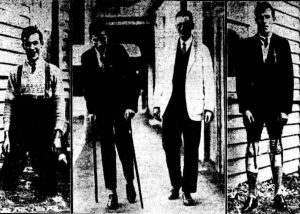
Maxwell Godfrey walks again, from the Mercury, 24 May 1928, p.5.
Lily Gresson, who had had some nursing experience in London, again showed her versatility by looking after the two patients in the hospital while Nurse Bessell accompanied the incapacitated man out to the railway station. Perhaps Lily also home schooled thirteen-year-old Wrixon. There were few children and no school at Adamsfield at this time, so otherwise he would have lost a year of his education.
And the Gressons’ Air B’n’B house? Well, while it was hardly the Adamsfield Hilton, it was comfortable enough by mining frontier standards—a paling hut with a big fireplace and a real glass window.[8] Lily Gresson might have been just a little ahead of her time. Hikers would soon be on their way to Adamsfield and the glorious south-west beyond. Ernie Bond would be besieged with them at times on his Gordon River farm, Gordon Vale, during the 1930s and 1940s. In 1952 the Launceston and Hobart Walking Clubs would even inherit Gordon Vale. Lily Gresson , pioneer of the Adamsfield diggings, was onto something!
With thanks to Dale Matheson, who showed me this story.
[1] ‘Board and residence’, Mercury, 23 November 1926, p.1.
[2] Lily Gresson; quoted by Fred A Murfet, in Sherwood reflections, the author, 1987, p.194.
[3] Lily Gresson; quoted by Fred A Murfet, in Sherwood reflections, p.190.
[4] In her account, Lily Gresson did not mention the notorious ‘Digger’s Delight’, the sly-grog shop and accommodation house that accompanied Chrisp’s Hut soon after the Adams River rush began. Perhaps Ralph Langdon and Bernie Symmons had already moved on into down-town Adamsfield, building Symmons Hall with its accompanying illegal boozer.
[5] Lily Gresson; quoted by Fred A Murfet, in Sherwood reflections, p.192.
[6] ‘Bush nursing’, Mercury, 22 July 1926, p.11; Elsie G Bessell, quoted by Marita Bardenhagen, Adamsfield bush nursing paper, presented at the Australian Mining History Association conference at Queenstown, 2008; ‘Sufferer in bush’, Mercury, 24 May 1928, p.5.
[7] ‘Maxwell Godfrey Fund’, Mercury, 27 July 1927, p.3; ‘Maxwell Godfrey walks again’, and ‘Sufferer in bush’; both Mercury, 24 May 1928, p.5.
[8] Lily Gresson; quoted by Fred A Murfet, in Sherwood reflections, p.192.
by Nic Haygarth | 09/07/17 | Tasmanian high country history
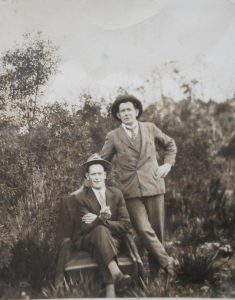
‘Mulga Mick’ O’Reilly (standing) and friend at Adamsfield, courtesy of the Tasmanian Archive and Heritage Office.
He was Irish, he was a dyed-in-the-wool member of the Labor Party, and he was a socialist. Those are things we can say with certainty about the ‘voice of Adamsfield’, ‘Mulga Mick’ O’Reilly. Beyond that, a lot of his life is open to debate. This well-travelled digger wrote two books, The Pinnacle Road and other verses (1935), which was a collection of his poems, most of them from his Tasmanian days, and the autobiography Bowyangs and boomerangs: reminiscences of 40 years’ prospecting in Australia and Tasmania (1944).
How reliable were they? Mick’s son John O’Reilly recalled his aunts saying that Bowyangs and boomerangs was mostly fabrication. In it he claimed tragic beginnings. Having been born at Shinrone, County Offaly, Ireland, in 1879, he lost his first wife and two sons in an influenza epidemic before coming to Australia. [1]
One of the things that makes it hard to keep track of ‘Mulga Mick’ is his way of acquiring other people’s memories. He loved to compose stirring poetry. He wrote as if he was the spirit of mineral prospecting, speaking for all the diggers. One of his efforts, ‘The men of ‘93’, was written about times on the Western Australian goldfields he probably never experienced. Perhaps he recorded the stories of old diggers, and then, like a true dramatist, he gave these immediacy by writing them up in the first person.
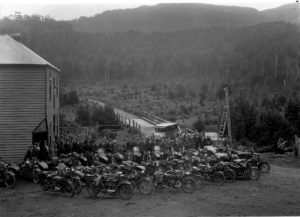
The Whyte River Hotel besieged by motorcyclists, probably in the 1920s. JH Robinson photo courtesy of the late Nancy Gillard.
In 1933 he wrote a lament for the Whyte River Hotel, which was the watering hole for the Nineteen Mile osmiridium field west of Waratah. The pub burnt down in 1929—and O’Reilly probably never laid eyes on it. Yet he described it with the utmost intimacy. Reading his poem, you would swear he had tied one with Jim McGinty, Tom Rouse, Sammy Dwyer and all the other veterans of the field. Even ‘old Burly Lynch’ the publican, lining the drinks up on the bar, got a run. Yet Lynch surrendered the licence of the Whyte River Hotel in 1912, many years before O’Reilly arrived in Tasmania.[2]
Likewise, ‘The Adams River Rush’ described an event he hadn’t attended.[3] The rush occurred in the spring of 1925. He was certainly at Adamsfield in 1928, and through the Great Depression years, the toughest times on that osmiridium field. During these years he delivered missives from the diggings that captured many facets of the experience—the longing for loved ones and the comforts of town; the misery of stirring from a warm bed to work in the mud; comic arguments and drunken fist fights; and the general scrap to make money and hang on to it.
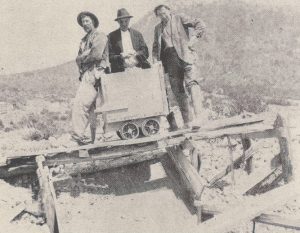
‘Mulga Mick’ (at right) trucking ore to the bin tip, with harry Hill and James Harrison, from the Tasmanian Mail, 13 January 1932, p.35.
Life was very simple for O’Reilly. The world was divided into ‘haves’ and ‘have nots’, that is, the parasite (the master) and the exploited (the servant). O’Reilly spelt ‘Digger’ with a capital ‘D’, whether that be the diggers of Adamsfield or the diggers of Gallipoli, because to him they were of the same manly ilk. All politicians were parasites who took the food from children’s mouths.[4] Miners’ wives and Adamsfield bush nurses were angels.[5] The press was also parasitic and should be ‘cleared from the face of all lands’, except, presumably, when newspapers bore his own copious contributions.[6] His penmanship was fluent, eloquent and often sympathetic to the down-trodden and forgotten, like the ‘heroes’ of Gallipoli, the elderly, the poor.[7] O’Reilly saw the Adamsfield osmiridium field as the epitome of the worker’s struggle for survival with dignity. He urged the workers to strike a blow for freedom against ‘pampered parasites [stealing] our children’s bread’, citing a particularly pathetic example of a large, young family forced to trudge out to the remote diggings.[8] ‘Out latest hospital: is not finished yet’, published in Hobart newspaper the Voice in 1931, was a protest about poor public infrastructure. Adamsfield was in the ridiculous situation of having a hospital with no bathroom, patients having to bathe in a passing water race:
‘When the smoke goes curling through the hole
Where the chimney ought to be,
And the old black billy on the fire
To make the evening tea;
When the hurricane lamp is lighted up,
Then you can safely bet,
It looks more like a Digger’s Camp
That is not finished yet.
If a patient ever gets a bath,
It’s on the instalment plan,
With just a little drop each day
From out the billy-can.
He rubs himself both her and there
Till he is partly wet:
Some day he may get over all,
For the bathroom’s not finished yet.’[9]
There was plenty of humour in his verse. When Jack Brennan claimed to have found a lode of osmiridium, O’Reilly predicted that it would only bring him enough money to buy a new commode.[10] In ‘The lady dentist’s visit to Adamsfield’ he described the anticipation of some rare female attention when Hobart dentist Olive Shepherd decided to make a business call to the diggings:
‘Some developed toothache that had never had a tooth
Since their father’s hairy lug they used to bite,
Another one’s got gumboils all around the ancient root
Of the one and only molar that’s in sight …
Not for years can we remember when excitement ran so high,
Or a ‘shepherd’ caused such stir among the sheep.
Now the old and toilworn Diggers wear a collar and a tie,
It’s enough to make the blooming angels weep.’[11]
However, O’Reilly’s pet plan to increase digger prosperity and extend the life of the osmiridium field was deadly serious. He wanted the government to fund a scheme to drain about 1000 acres of swampy flats along the Adams River which he claimed he had already tested successfully for metal. Without producing a single assay report as evidence, he claimed this would return about £200,000-worth of osmiridium.[12] The idea was to drain the area by way of a deep tail race terminating at the Adams River Falls, although others hit upon a more radical plan to blast away the falls themselves, thereby increasing the river flow. Asked to report on the scheme in 1931, Government Geologist PB Nye claimed that the area which would benefit from drainage was at most 667 acres and that insufficient work had been done to prove that the ground in question contained payable osmiridium—let alone osmiridium that would justify an outlay of anything up to £10,000 on such a tail race.[13]
O’Reilly retired to Glenorchy, took a job as a labourer building the Pinnacle Road up Mount Wellington, above Hobart, and continued to fire off instructions for a better world. St Peter probably copped an earful as ‘Mulga Mick’ stormed the Pearly Gates.
[1] MJ O’Reilly (‘Mulga Mick’), Bowyangs and boomerangs: reminiscences of 40 years’ prospecting in Australia and Tasmania, Hesperian, Carlisle, WA, 1984 reprint, p.160; John O’Reilly, ‘Mulga Mick; prospector, miner, author and poet: a lost father rediscovered’, Tasmanian Ancestry, December 2013, p.149.
[2] The old Whyte River Pub’, Advocate, 16 September 1933, p.8; reprinted in MJ O’Reilly, ‘Mulga Mick’, The Pinnacle Road and other verses, the author, Hobart, 1935, pp.62‒64. The Whyte River Hotel was never rebuilt.
[3] MJ O’Reilly, ‘Mulga Mick’, ‘The Adams River Rush’, The Pinnacle Road and other verses, pp.55–57.
[4] See, for example, ‘Mulga Mick’ (MJ O’Reilly), ‘Stealing the children’s bread: lesson of the Adamsfield Track’, Voice, 30 April 1932, p.7.
[5] For diggers’ wives and bush nurses as angels, see MJ O’Reilly, ‘Mulga Mick’, ‘The ossie diggers’ wives at Adamsfield’, in The Pinnacle Road and other verses, the author, Hobart, 1935, pp.28‒29; and ‘Sister’s sympathy’, Voice, 11 April 1931, p.6.
[6] For the ‘parasitic press’, see ‘Mulga Mick’ (MJ O’Reilly), ‘A poetic exchange’, Voice, 16 May 1931, p.2.
[7] See ‘Mulga Mick’ (MJ O’Reilly), ‘Armistice Day: “We’ll ne’er forget the price”’, Voice, 7 November 1931, p.1; and ‘Stealing the children’s bread: lesson of the Adamsfield Track’, Voice, 30 April 1932, p.7.
[8] ‘Mulga Mick’ (MJ O’Reilly), ‘Stealing the children’s bread: lesson of the Adamsfield Track’, Voice, 30 April 1932, p.7.
[9] ‘Mulga Mick’ (MJ O’Reilly), ‘Not finished yet’; quoted in ‘Our latest hospital’, Voice, 3 January 1931, p.2.
[10] ‘Jack Brennan’s osie [sic] lode’, poem signed ‘Mulga Mick’, dated 1929, and reprinted in CA Bacon, Notes on the mining and history of Adamsfield, Report, no.1992/20, Mineral Resources Tasmania, Hobart, 1992, p.8.
[11] MJ O’Reilly, ‘Mulga Mick’, ‘The lady dentist’s visit to Adamsfield’, The Pinnacle Road and other verses, pp.47–48.
[12] ‘Mulga Mick’ (MJ O’Reilly), ‘Osmiridium diggers’, Mercury, 2 September 1932, p.8; MJ O’Reilly, ‘Adamsfield development’, Mercury, 7 February 1933, p.6.
[13] PB Nye, ‘Proposal to drain the Adams River Flats by constructing a deep tail race at the Adams River Falls’, Unpublished Report, 76–79/1931, Department of Mines, Hobart, p.78; ‘Osmiridium’, Mercury, 16 January 1933, p.5.







